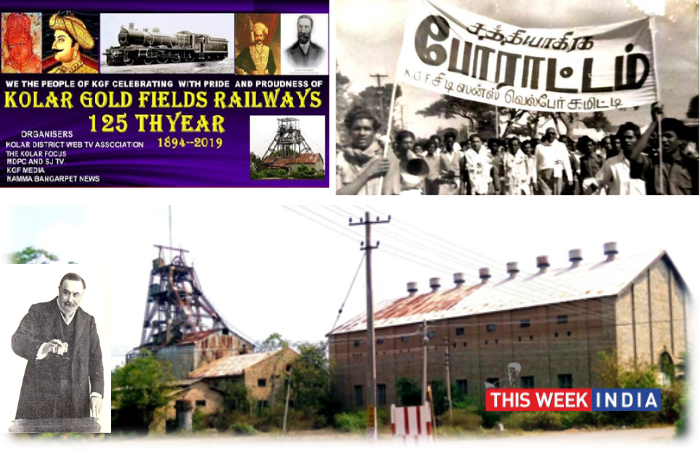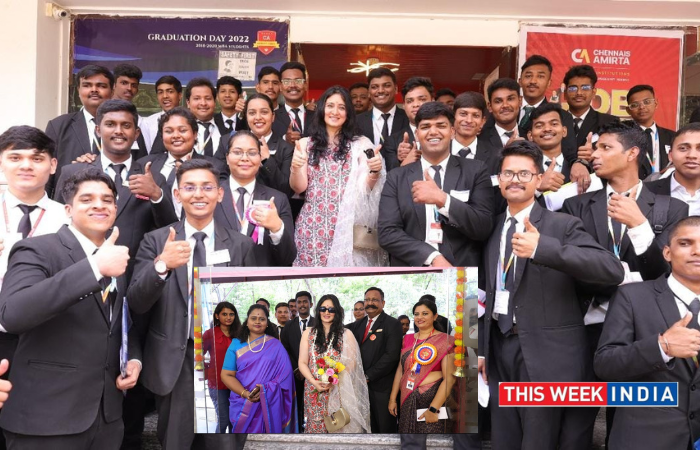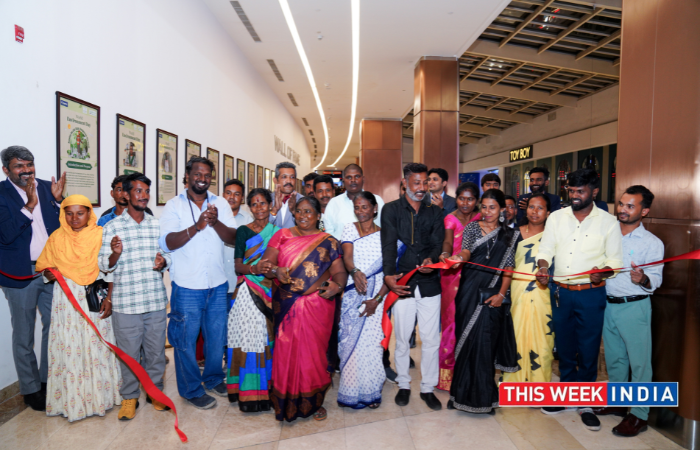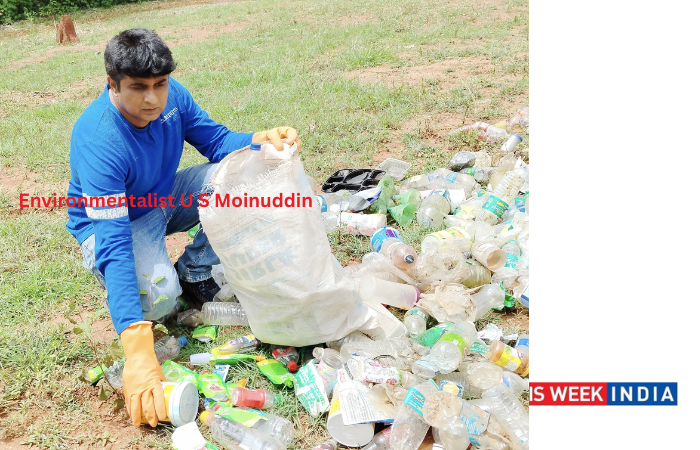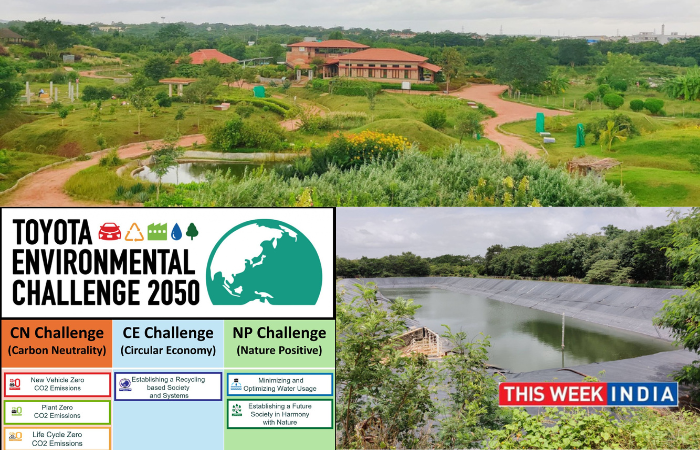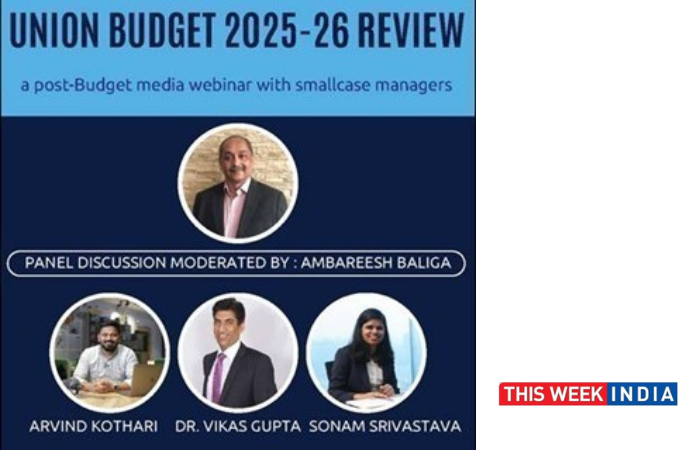The Kolar Gold Field’s world wide famous for the precious yellow metal gold. This region was once believed to be the part of Dhandagrunyam forest in which the hero of Ramayana epic Rama, his wife Seetha & his brother lakshmn spend some years in this region in their 14 years of Vanavasa .the author of the epic Ramayana Valmigi Munivar was also believed lived in Avani mountains near KGF. Where Seetha and her two sons lava, Kusha were also brought up in this region. Seetha worshipped as Goddes in this region a temple of Seetha Devi in Seethamma mountain is still exist here and believed under the footsteps where she walked gold was formed also in this place the great Rama killed the discussed golden deer Maarisan, uncle of the great king Ravanan of Srilanka. When Rama killed Maarisan by arrow, he broke into pieces of gold and spread in this region, this is the folktale people believe.
Early days this area was a barren hilly and full of rocks and stones. The gold mining operation in this area is as old as more than 3000 years. As it is written in the Holy Bible (1 King 9:28) King Solomon sent his ships to O’-Phir (Southern part of India) and brought gold to built the house of Lord and also his palace.
77 AD: Roman historian “PLINY” recorded about the gold mine workings in this area while passing through this region.
500 AD: During the region in South India various dynasties including Emperor Ashoka and Gupthas in 5th Century the Cholas, Vijayanagara Empire, Pallavasa and in 18th century the Mysore King Tippu Sultan also tried and continued the mining activity in a small scale did not go down to more than 300 feet below surface.
1802: Authentic record of KGF gold mining activity is from a report of Lieutenant JOHN WARREN, a British Army Officer while undergoing a land survey on the eastern boundary of Mysore near Yerrakunda. Heard about the presence of gold near a village Urigaum (Oorgaum). After 2 years of study with the local people. But the attempts were not successful.
1860: the British retired Army Officers from Bangalore Cantonment join together formed a syndicate and tried to extract gold and failed.
1871: the reincarnation of the gold mine became when MICHACLF LAVELLE an Irish soldier who had acquired himself with gold mining in Newzeland came to Bangalore in 1871 and landed in KGF.
1875: entered in to the first lease agreement to mine gold and other materials was avail in 1875. The concession lease agreement covered an area of 20 sq. miles.
1877: Michal f Lavelle could not however precede lacking resources in finance. He sold his rights to Arbuthnot &co., of Madras under the supervision of an Australian miner JOHN MUNDY. This company extracted some gold as expensive the project was abandoned.
Eventually the lease concession was acquire by the kolar concessionaries a syndicate of army personal headed BY GEORGE DELAPOETBERESFORT. They also sold some of the gold bearing land they acquired. Over next couple of years at least 11 private companies were floated most of then gave up and closed the operation.
only 5 gold companies namely Mysore mine gold company, champion mine gold company, Urigaum mine gold company, Balghat mine gold company and Nundydroog mine gold company where operating.
1880: the Mysore mine company hired British mining engineering firm m/s john Taylor & sons where operating the gold mines in Africa.
1883: Mr. john Taylor came to India and took over the gold mines at last ditch efforts was made in 1883 and they struck gold, the Veines where so rich an extensive they sink 4 more shafts in that area.
The mining needed men to work since mining was a labour and dangerous job, the locals were reluctant to give up their traditional occupation of cultivation and enter in to this risky profession. Even though the company where offering all facilities. Though the gold field lay in the Mysore territory, they were on the border of Tamil speaking areas. It was an idle situation to British company they exploited as well as they could.
1884: large quartz (champion reef) with high value of gold was discovered by Captain Plummer in Mysore mine (Plummer’s shaft. the next 2 decades were years of peak production. (1881-1890) 750 KGS of gold produced.
1890: the KGF hospital with 10 beds was started to treat the European officers of the mine.
1894: The railway lines to the mining area from bangarpet known as kolar road station were laid on 15 February 1894.
1902: arrival of electricity to KGF mines generated at Shivasamudram. Prior to this electric power animal power (Oxes & Donkeys), steam power were used for mining operations of machineries. Lines were layed.
1903: to supply portable drinking water to KGF water purification plant was constructed at Bethamangala Lake near KGF. The labour force member up to maximum of 35000 during 1907.
1909: the mining observatory to monitor the rock burst were installed.
1912 : WITCHARD SEISMIC LABORATORY to record the rock movements were installed.
1923: central mine rescue station established for mining rescue operation, first time of its kind in Asia.
1925: 20 members of sanitary board of Robertson pet, Anderson pet and villages were formed.
1930: signs of decline of the gold mine started showing up. Balghat mines were closed. labour strength dropped from 18454 to 17312 in one year.
1931-1940: there was an upsurge in production of gold; the employment went upto 27000 due to sinking of the deepest shafts of KGF.
1940: the first trade union was formed in KGF by the KGF mine workers. Since the union was not having legal authority to function from KGF, the office was located at kuppam which was not mining area.
1941-1950: the production performance of the mines started dipping due to the fall of production.
1941: Legal rights were granted to workers to form trade union, after the Mysore labour emergency bill was passed.
1953: the oorgaum gold mines were closed.
1956: nationalization of gold Company: all the mining companies of the KGF were taken over by the govt. of Mysore on 29th November 1956. The nationalized company functioned as KGMU (kolar gold mining undertakings)
1962: government of Mysore after realizing the Burdon of running these giant industries profitably. Approached the govt. of India with a request to take over KGMU the government of India took over the mines and placed it under the department of finance.
1972: the KGF mines were Amalgamated as Bharat gold mines limited (BGML). BGML was formed in the public sector under the department of steel & mines
1987: BGML decided to close down the deep mines restrict the deep of 3.200 ft as a result the production of gold decreased.
GOLD PRODUCTION & LOSS
1997 – 2000 gold produced 492.92 kgs. Sale of gold: 2177.50 lakhs,loss:5420.67 lakhs
1992: BGML WAS CATEGORISED AS A SICK INDUSTRY and referred to board for industrial finance & reconstruction (BIFR). As per the government. Of India low grade gold ore resources increasing the depth of the mines azards of deep underground mining and falling of profits, the company was stopped its operation and waiting for the official winding up. New appointments were stopped by mid 1980. A good number of workers were relieved under voluntary retirement scheme and normal retirement.
1972-1977 average employees 12, 29298
In 1977-2000 average employees were 4333.
1993: appointed ICICI as the operating agency on 27-7-1993 to prepare a revival/ rehabilitation package.
1995: a memorandum of understanding with Norrandy Anglo Asian limited (NAAL), a south African mining company as joined venture partners for exploration and exploitation of gold from KGF. But within 6 months the NAAL withdraws from the joint venture.
1996: even before operating agency (OA) could submit its final report, based on the early reports BIRF ordered winding up the gold mining company.
1997: this order was challenged by BGML in industrial finance, reconstruction AAIFR appellate authority. The operating authority (OA) submitted three reports in 1994, October 1996 and July 1997. The OA submitted a rehabilitation scheme of Rs. 200 crores as investment. Writing off the loans and the interest by government of India during 1993-1994. The loan amount was 85.93 crores. by 1997 -1998 this has gone up to 163.18 crores.
1998: the government of India expressed their inability in investing further funds. Option for finding out a suitable joint venture. A committee was constituted to identify a co-partner. Global tenders were floated. The committee could not identified a bidder with technically, financially suitable to rehabilitate BGML.
2000: the government of India came to the conclusion that revival of BGML was not possible and informed BIFR to wound up the BGML under the provisions of sick industrial company act (SICA). BIFR was informed this provision on 27-1-2000. After 8 years of declaring the KGF gold company, sick and referring it to the BIFR, the BIFR passed the order to close down the BGML.
Though this closing order of BIFR was challenged by workers union and also an Australian company Karnataka gold mining NL appeals were filed with appellate authority for industrial finance and reconstruction (AAIFR). But all the appeals were dismissed and AAIFR confirmed the BIFR order for closure.
2001: on this decision BGML obtained the permission of government of India to close the mining company under section 25(0) of the ID act-1947 with effect from 1-3-2001. This closure move was challenged in high court of Karnataka by workers union and BGML officers association on 16-3-2001.
the single judge of high court of Karnataka squash the orders of BIFR, AAIFR and government of India and ordered to reconsider the claims of the petitioners and to find a ay to revive BGML.
2003: the above order of single judge of high court of Karnataka was challenged by the government of India and BGML on 9-4-2001 before the double bench of high court of Karnataka. The high court passed its order setting the orders of single judge. With some recommendations to the government of India to do justice to poor suffering BGML employees and to consider any fresh proposals for revival of BGML.
2022: 01 Long years passed away without any decision from government of India. It is still in unfinished story. Many employees passed way during this period and people still waiting to era justice from government of India. Since the central government has not come forward with any alternate scheme of employment, people of KGF on their own are making efforts to survive employment.
Rehabilitation and compensation have all being and successful. Daily about 20,000 people from KGF mostly women, youth and even old employees make the long arduous journey in over crowed trains to Bangalore. Most of their time 5 to 6 hours a day spent on travelling, living them no time to spent with their families. They are living in mining houses which is 100 years old not maintained by the company any more without a portable drinking water, sanitation, hospital facilities living with a hope the government and leaders will do some justice to this KGF. it is still an unfinished story.
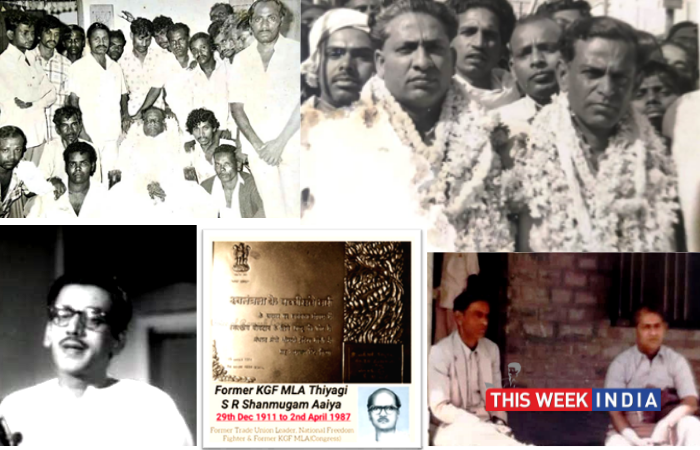
THE great & selfless leaders like K.S.Vasan,VM.Govindan,Vajravelchetty,T.S.Swaminathan,Savaridoss,T.S.Mani and also some of the selfless leaders other than the Left movement.Dear friends among all I believe Com K.S. Vasan is incomparable.Though the mining work was started in full pledge in the 1880’s,untill 1940 there was no organised Unions for the workers.The workers were denied not only proper wages but we’re working in a hazardous conditions without any safety.At one stage they were treated has prisoners Vajravelchetty was instrumental in bringing Com KS.Vasan from Tamil Nadu & Com VM Govindan from Gandhi P.Ramamurthy sent Com KS Vasan to guide Com VM.GOVINDAN to build the trade union movement in KGF.From that day Com VASAN selflessly fought for the rights of the mine workers. In 1946 along with Com Govindan he led a historical 77 days strike and succeeded. All the workers demands were solved. The Then Management & the opposition who could not tolerate the success planned to murder Com Vasan, they hired goondas & sent. He was attacked severely, he was stabbed in the hand & body, One Comrade Madhavan who was there covered Com KS VASAN with his body took the stabs and saved Com VASAN. Thousands of workers who knew that their leader was stabbed came out of the mines and protested in Malayalee grounds to arrest the culprits.Police opened fire & 6 young comrades were martyred.The selfless service of Com Vasan continued.He was the General Secretary of Champion mines Union & the President was none other then Shri K.C.Reddy the first chief minister of Mysore state.In 1952 Com Vasan was elected the first MLA of KGF.In 1956 he organised the workers & was instrumental in Nationalisation of the Kolar gold mines,He organised the Bgml workers to support the great struggle of the farmers of Kolar district,In 1964 he along with other leaders of KGF,with the support of karmaveerar Kamaraj brought Beml factory to kgf(during that time oorgaum mines was closed).He convinced the Bgml management and made kgf company hospital service available to all.Sanitary board & municipality was brought by him.He came to kgf at the age of 24 and till his last breath 14.10.1979,he worked for the upliftment of kgf people.He used to sit in upavasa satyagrahas in the struggles which made him to vomit blood in his last days.He lived in kgf unmarried, our house was his house, we were his children,brother,sister everything,Only his dead body was given to his family. They requested “since he was 24 years of age,we have given our boy to you, please give him at least now “He was a good friend of late Shri Byrareddy solicitor general of karnataka. Friends such was the sacrifice of Com. KS Vasan & other leaders of CPI(M).In Today’s situation let us follow the footsteps of Com Vasan who followed the Marxist principles till his last breath, He was a true Makkal Thalaivar(People’s leader).
Why is this day is a special for KGFians?
“ KOLAR GOLD FIELDS RAILWAYS” Since 127 Years (1894-2021 Going on)A small history about awerness on KGF railway during Celebrations at Marikuppam Railway Station. Being a KGFion is always given us the pride and proud moments for us, because for being in this world class city. This year is being 127 years (1894-2021) of KGF railways, on this mile stone, I would like to recollect the history of KGF railways. In the year 1894 under Mysore Government “Madras Railways Company “(Presently Indian Railways) had laid the railways lines between Boweringpet to Marikuppam with a total capital cost of around Rs 6, 37, 204 for completing this project which had around Four(4) Railway stations i.e., Marikuppam, Champion, Oorgaum and Coromandel.The KGF Railway’s was one of the reasons for increasing the gold production in Mining. Prior to Railways in KGF, The gold production in the year 1890 was around 750Kgs/year. After the implementation of railways in KGF the transportation and communication increased with new arrival of raw materials and new mining equipments, thus the gold production was increased and the production in year 1900s was around 15000kgs/year. At present this Railway is used as a mode of transportation for getting daily bread for most of our families. Hence on this Mile stone we should be happy and proud.
Awarded by Government of India in 1972 as freedom fighter for Aaiya SR shanmugam Who is Thiyagi SR Shanmugam( 29th Dec 1911- 2nd April 1987) 1)He was a Trade Union Leader, 2)He was Freedom Fighter, Government of India Recognized and Awarded Aaiya as Freedom fighter. 3)He was former MLA of KGF, When he expired he had only Rs 150 in his pocket , When I think about this leader, I feel guilty about myself. Yes we KGF ites , all should feel guilty of our self not remembering the sacrifices of Thiyagi S R Shanumugam Aaiya. Aaiya sacrificed his life for KGF people. His family who sacrificed his life for all the BGML mining employees. Today as we are is because of good leaders and Sacrifices of good leaders of KGF. One among such leader was Aaiya SR Shanmugam .I personally Bow to his family and all there sacrifices for the welfare of KGF people. When Aaiya Expired he had only Rs 150 in his pocket. Coming 29th Dec is Aaiya’s 111th Year Birthday, Aaiya was born on 29th Dec 1901 .On his birth Anniversary Day a few points of elected leaders who are in Power. We also planned to give memorandum about the below to the administration & Elected leaders. 1) Statue of Thayagi SR Shanmugam aaiya have to be kept in KGF.2) Pandara line name is also called as Thayagi SR Shanmugam Nagar 3) Government should honor Thayigi SR Shanmugam Aaiya’s family by providing five (5) Acres of land to them. 4) Government should honor Thayigi SR Shanmugam A’saiya family by providing at least two (2) state government jobs to his family members. This is a small favor of credit which we can pay back to the sacrifice of Thaygi SR Shanmugam Aaiya and his family. Finally I hope the public, or any political party and congress party will celebrate this great leaders birthday on 29th Dec 2021. Today in many place we could see banners and cut outs of birthday wishes, Xmas wishes, new year wishes and Pongal wishes from many political and NGO organizations sharing the wishes. we wish the same way we respect our leader who sacrificed his life for our benefits. Let’s Remember our Hero Thayigi SR Shanmugam Aaiya and pay our respects.Contribution of Federation Trade Union for 1930s & 1940 Protest under the leadership of Aaiya JC Adimoolam & PM Swamidurai KGF saw huge protest in 1930s & 1940s. Even Communist & Congress Leaders Like SR Shanmugam , KS Vasan Aaiya had a great roles during this protest for fighting people’s rights.Today’s youngsters should really know about those protest and how strong people were Following with ideology let it be Communist or Republican.KGF Land of real , True Communist & Republican’s
In 1930 Strike- Huge Protest by KGF People Contribution of Aaiya SR Shanmugam Former KGF MLA
Aaiya SR Shanmugam during the strike period in the presence of a big crowd fixed a bamboo pole in the centre of the High Grounds at Marikuppam and made his wife remove her mangalsuthra and hung it on the pole vowing that the same will be worn again by her only after the unions are allowed for the mine workers
The Man MA Sreenivasan One Man commission changed the life style of every KGF people in 1930. The unity of KGF mining worker’s and family which were forced to Mysore government those days to send MA Sreenivasan to KGF to study KGF mining worker’s problem. Shortly planning to make a video about 1930 & 1940 KGF mining Protest history. I wish each and every KGF citizen should know this history and teach the same to their next generation. Today I read some unknown history about KGF 1930 & 1940 Protest. Those who read these protest can compare the similar cruelty to the recent movie Jai Bhim. Those who read this 1930 & 1940 Protest for mining worker’s , then each and every KGF residents will vote only for a KGF candidate. How cruel was John Taylor & Sons Committee (JTSC) was towards mining worker’s. The Indian Trade Union Act 1926 was brought into force on 1st June 1927. The Act was extending to the whole of British India, including Baluchistan and Santhal Parganas. The Act was not implemented in Mysore. Reason for such move was to prevent united action by the workers and also the pressure from the various employers. But during 1940 all the major industrial centers of Mysore including KGF witnessed strong and prolonged protests by the workers. The strike was more vigorous in KGF and Bangalore. The outcome of these protests was the passing of the Mysore Trade Union Bill on 24th December 1941 and later on the Mysore Labor Act 1942. The new law permitted the registration of unions and ensured legal recognition. The primary intention of the Bill was to prevent strikes and lockouts and to solve all the industrial disputes by conciliation and arbitration. The Act however forbade the formation of industry wise union and the Trade Union Act 1926 was made applicable only in 1951. VP Menon- The Forgotten Architect of Modern India Worked in KGF Mines as Coolie in earlier days. Then rest is Powerful Place Made Powerful People-KGF . After the independence of India, Menon became the Secretary of the Ministry of the States, headed by Sardar Vallabhbhai Patel, with whom he had developed a bond of trust. Patel respected Menon’s political genius and work ethic, while Menon obtained the respect for his work that a civil servant needs from his political superior.Menon worked closely with Patel over the political integration of India, in which, over 565 princely states were merged into the union of India, managing the diplomacy between the States Ministry and the various Indian princes, acting as Patel’s envoy and striking deals with reluctant Princes and Rulers. Patel respected Menon’s ingenuity in diplomacy, and often did not question if Menon exceeded any instructions. Menon also worked with Patel over the military action against the hostile states of Junagadh and Hyderabad, as well as advising Nehru and Patel on relations with Pakistan and the Kashmir conflict. The Cabinet had dispatched Menon to obtain the accession of Kashmir into India in 1947.

What will he say if he visits KGF now? By seeing kgf roads and all companies go outside kgf when world famous magician visited KGF what he felt. Charles Bertram was a British magician known as “The Royal Conjurer” as he performed for royalty. He has said that KGF was the finest place in entire south India. High time to everyone to take social responsibility.
Narrated and Compiled by Dr. Suresh Babu, Practicing Senior Radiographer, Lab Technician & Media Publisher.

